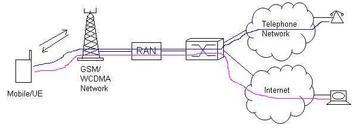Optical Circuit Switching vs. Burst Switching vs. Packet Switching
This article compares Optical Circuit Switching (OCS), Optical Burst Switching (OBS), and Optical Packet Switching (OPS), highlighting their differences, advantages, and disadvantages.
 Figure 1: Evolution of Optical Switching Techniques
Figure 1: Evolution of Optical Switching Techniques
Figure 1 depicts the evolution of optical switching techniques, encompassing OCS, OBS, and OPS.
- OCS (Optical Circuit Switching): Adds functionalities to point-to-point WDM (Wavelength Division Multiplexing) networks. Switching occurs at intermediate routers between source and destination devices.
- OBS (Optical Burst Switching): Switches bursts of data optically instead of electronically and does not employ buffers.
- OPS (Optical Packet Switching): Switches and buffers packets in optical form before forwarding them to the next hop in the network.
Optical Circuit Switching
 Figure 2: Optical Circuit Switching
Figure 2: Optical Circuit Switching
Figure 2 illustrates optical circuit switching. It operates on the principle of wavelength routing, where a dedicated wavelength is assigned to each path from source to destination.
- Once a connection is established, the data remains in the optical domain (light form) until it reaches the destination.
- A circuit connection is established between devices before communication begins.
- The connection can be fixed or dynamically created as needed. While multiple paths may exist between source and destination, only the established path is used for communication.
Advantages of Optical Circuit Switching
- Supports natural QoS (Quality of Service).
- Commercially available.
Disadvantages of Optical Circuit Switching
- High wavelength consumption.
- Low flexibility.
- Lower network utilization.
- Large node size.
Optical Burst Switching
 Figure 3: Optical Burst Switching
Figure 3: Optical Burst Switching
Figure 3 depicts optical burst switching. In this technique, client data undergoes burst assembly and disassembly at each network edge. Multiplexing happens at the burst level, where IP packets are fragmented into smaller bursts at the OBS network core.
- Data and control signals are transmitted on different wavelengths or channels. O/E/O (Optical-Electrical-Optical) conversions are performed on a few control channels, which saves cost as such conversions are avoided on a large number of channels.
Advantages of Optical Burst Switching
- High flexibility.
- Efficient network utilization.
Disadvantages of Optical Burst Switching
- Complex traffic aggregation.
- More complex resilience.
- Complex control mechanisms.
Optical Packet Switching
 Figure 4: Optical Packet Structure
Figure 4: Optical Packet Structure
In optical packet switching, the packet header is processed either optically or electronically at each intermediate node. Optical/Electronic (O/E) conversion and vice versa are performed as required. The data payload waits in fiber delay lines before being forwarded.
Figure 4 shows the optical packet format/structure, consisting of a packet train where each individual packet includes an OGB (Optical Guard Band), header, and synchronization data.
Advantages of Optical Packet Switching
- Reduced node size.
- Very flexible utilization of network.
- Very efficient network utilization.
Disadvantages of Optical Packet Switching
- Higher control complexity.
- More effort required for packet recording.
Comparison Table
The following table summarizes the key differences between Optical Circuit Switching, Optical Burst Switching, and Optical Packet Switching:
| Specifications | Optical Circuit Switching | Optical Burst Switching | Optical Packet Switching |
|---|---|---|---|
| Bandwidth | Lower | Higher | Higher |
| Data size supports | >GB of data | 100 to 1500 Bytes | Tens of kbytes |
| Overhead | Lower | Lower | Higher |
| Latency | High | Low | Low |
 RF
RF



